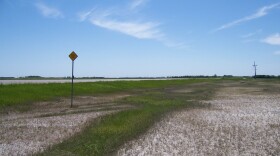September is upon us! As you have probably noticed, the days are getting shorter and cooler. Daylight has been decreasing since the summer solstice back in June. Sunrise and sunset on September 1 in Bismarck are 7:02am and 8:23pm, respectively. On September 30, sunrise and sunset in Bismarck will be 7:40am and 7:25pm.
Daytime highs and lows will also start dropping. The average high and low for Bismarck in August are 83° and 56°, respectively. It will drop to 72° and 45° for September.
The harvest moon, the full moon closest to the autumnal equinox, is coming up on September 18 this year. It will also be a super moon. Plus, there will be a partial lunar eclipse around moonrise. Then, the autumnal equinox will occur on the 22nd, when we will have roughly equal amounts of day and night.
As one looks out over the landscape, it is dotted with the yellows of goldenrods and sunflowers as well as some white and lavender from the fall asters. There are other colors, of course. The little bluestem, a common bunchgrass, will be adding a rich red-burgundy to steep hillside on the native prairie. And if it hasn’t already, the woodlands will start turning color, adding splashes of red, yellow, and other colors to the landscape.
September is also a busy time for the animals. Some of you may have already noticed tiger salamanders crossing the road, particularly after a rain. They are looking for a place to hold up for the winter. Beavers have been busy piling up branches in the water near their lodges to provide a food supply to get them through the winter. Squirrels and others will be busy gorging themselves and caching acorns and other seeds while they can.
Some migratory birds, such as many shorebirds, have already headed south for the winter. But perhaps the most widely recognized characteristics of September in North Dakota are the sights and sounds of migrating waterfowl overhead.
If you are interested in learning more about bird migration, you might want to check out BirdCast. You can check out the bird migration forecast maps, live bird migration maps, local bird migration alert, and the Migration Dashboard where you can explore nightly migration data in your region.





